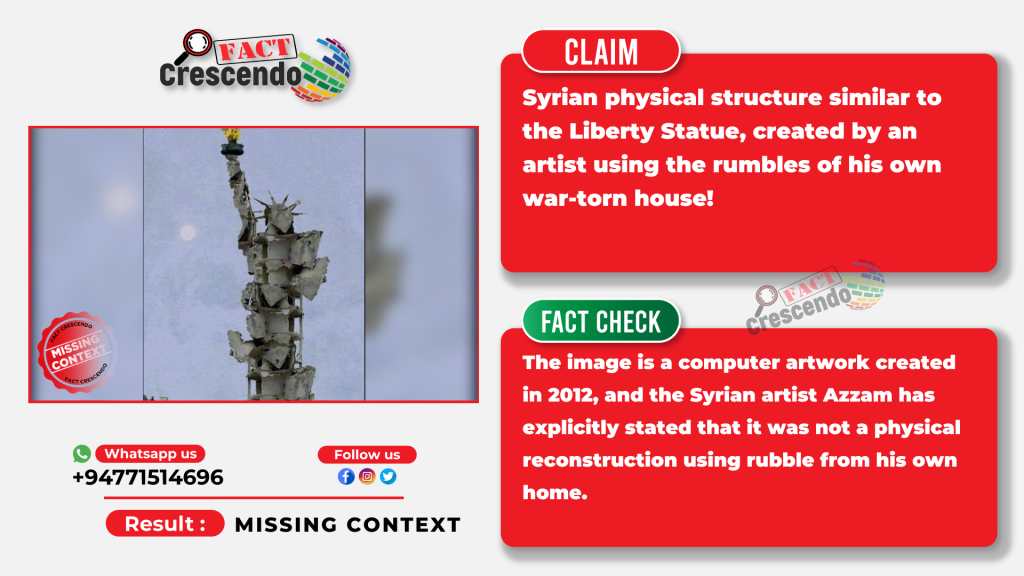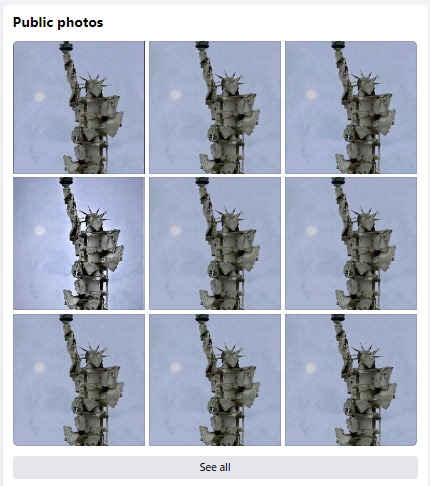
The Syrian population has been enduring prolonged suffering as a result of the ongoing civil war in their country. In response to these hardships, some Syrian artists created artworks that vividly depict the challenges faced by the people and the brutal realities of the conflict. However, our investigation reveals instances where these artworks have been misinterpreted and misrepresented on social media at various times.
Social Media Posts
Social media posts based on an image say that a Syrian artist had created a statue similar to the Statue of Liberty in the USA using the rumbles of his own house, destroyed due to the ongoing war.

The claims were shared widely in the Sinhala language as well.

We decided to do a fact-check on this.
Fact Check
From keyword searches, we found that this had gone viral back in 2016 as well. We found an archived version of an interview by Al Arabia with artist Tamam Azzam in 2016, where he cleared the confusion about his artwork and viral social media posts about it.
In an interview with Al Arabia English, Tamam Azzam stated that the claim is a “wrong interpretation” of the image. He expressed surprise at the high traction of the misinterpreted image, compared to the positive reactions initially in 2012.
Artistic Process in Creating the Artwork: Azzam clarified that the statue was not physically rebuilt with debris from his own house. Instead, it was created as a computer artwork in 2012. The work involved a ‘photomontage’ on the computer, using photos of war-affected buildings in Syria. As seen below, Azzam posted the artwork on his Facebook in September 2012.
Azzam emphasizes that the Statue of Liberty was chosen as a symbol of freedom, not as a representation of U.S. politics.
Message of Optimism: Azzam explains that, at the time of its creation, the piece carried a message of optimism despite the destruction in Syria. However, he noted that this was long ago and did not respond to people using the image in a context he had not intended.
False Origins Shared by Pro-Assad and Regime Loyalists: Azzam mentioned that the image was being shared by pro-Assad and regime loyalists who falsely claimed that it was a Syrian artist using his own destroyed home in Aleppo. This indicates a deliberate misrepresentation of the artwork’s origins.
More on Tamam Azzam: Born in Damascus, the capital of Syria, Azzam currently lives and works in Berlin. More on his life story can be read on Azzam’s website. There is a separate section on Tammam Azzam’s official website on photomontage creations on different themes. Here is a collection he classified under the theme of the Syrian museum.
After leaving Syria in 2011, Azzam found himself looking for new ways to create art and express his feelings about the loss of his home country, which prompted him to create the above CGI of the Statue of Liberty.
The archived Al Arabia interview can be reached here. Other explanative articles about this can be read here | Archived
Follow us and stay up to date with our latest fact checks.
Facebook | Twitter |Instagram | Google News | TikTok
Conclusion:
The claim that Tamam Azzam rebuilt the Statue of Liberty with debris from his own house is false. The image is a computer artwork created in 2012, and Azzam has explicitly stated that it was not a physical reconstruction using rubble from his own home.

Title: This is NOT any Syrian physical structure similar to the Liberty Statue, but computer-generated artwork!
Written By: Kalana KrishanthaResult: Missing Context






